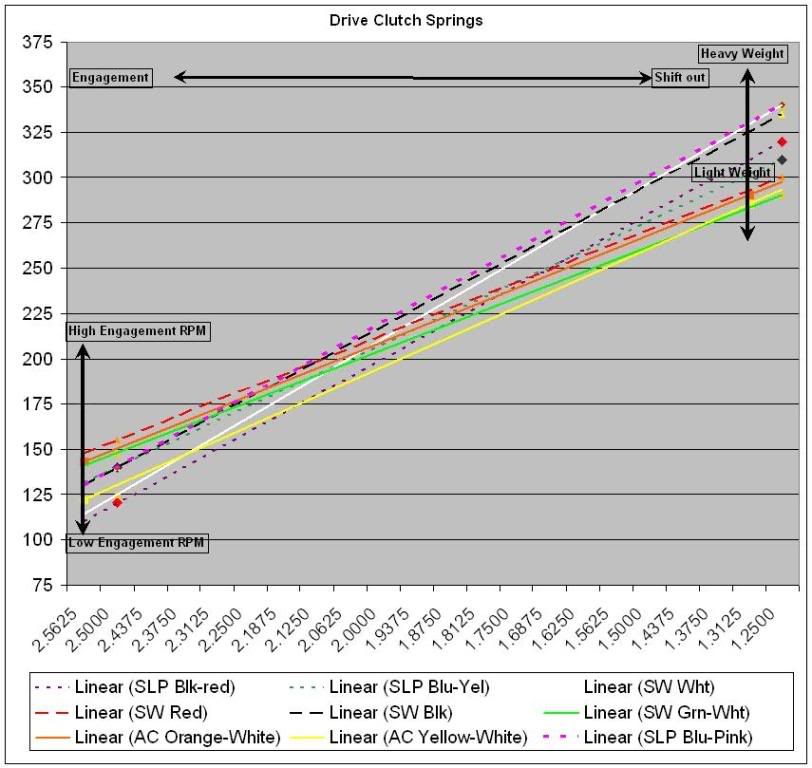I was always taught to "load the motor" as I learned snowmobile clutching. That meant to make the engine work (struggle possibly) to pull shift speed RPM. I did this with great success on my past sleds.
To add another factor to the primary clutching equation, I found that using the highest total force spring available allowed me to throw more weight (through my clutch weights) at my primary clutch and engine. This of course made the engine work even harder to pull top RPM because my primary weights had to be very heavy to keep from over reving with high total force springs.
I ended up sticking with the highest total force primary spring available and used it as a constant. I also learned a couple of things when I started playing around with clutch weights.
1. Heavy clutch weights seem to make the sled less snappy (rightfully so)because the engine has to work so hard to overcome all that weight. Lighter clutch weights seem to make my sleds feel much more snappy and dirt bike like.
2. Heavy clutch weights that can be pulled easily by a sled at lower elevations become insurmountable for the engine to pull as the elevation increases.
My question is: Is a sled able to reach it's full power potential when a primary spring of less than high total force is used?
If a lower total force spring is used, lighter weights consequently have to be used and the motor isn't being loaded as hard as it could be if one was using a higher total force primary spring.
The reason I ask is, my SLP Performance Edition Kit came with a primary spring with a rating of 160/310. I also see SLP makes a primary spring that is a 160/340. If I apply the above theory, I could theoretically throw more weight at the primary (and load the motor harder) potentially pulling a few more horsepower out of the motor if I used the higher total force spring.
What do you guys think?
To add another factor to the primary clutching equation, I found that using the highest total force spring available allowed me to throw more weight (through my clutch weights) at my primary clutch and engine. This of course made the engine work even harder to pull top RPM because my primary weights had to be very heavy to keep from over reving with high total force springs.
I ended up sticking with the highest total force primary spring available and used it as a constant. I also learned a couple of things when I started playing around with clutch weights.
1. Heavy clutch weights seem to make the sled less snappy (rightfully so)because the engine has to work so hard to overcome all that weight. Lighter clutch weights seem to make my sleds feel much more snappy and dirt bike like.
2. Heavy clutch weights that can be pulled easily by a sled at lower elevations become insurmountable for the engine to pull as the elevation increases.
My question is: Is a sled able to reach it's full power potential when a primary spring of less than high total force is used?
If a lower total force spring is used, lighter weights consequently have to be used and the motor isn't being loaded as hard as it could be if one was using a higher total force primary spring.
The reason I ask is, my SLP Performance Edition Kit came with a primary spring with a rating of 160/310. I also see SLP makes a primary spring that is a 160/340. If I apply the above theory, I could theoretically throw more weight at the primary (and load the motor harder) potentially pulling a few more horsepower out of the motor if I used the higher total force spring.
What do you guys think?






